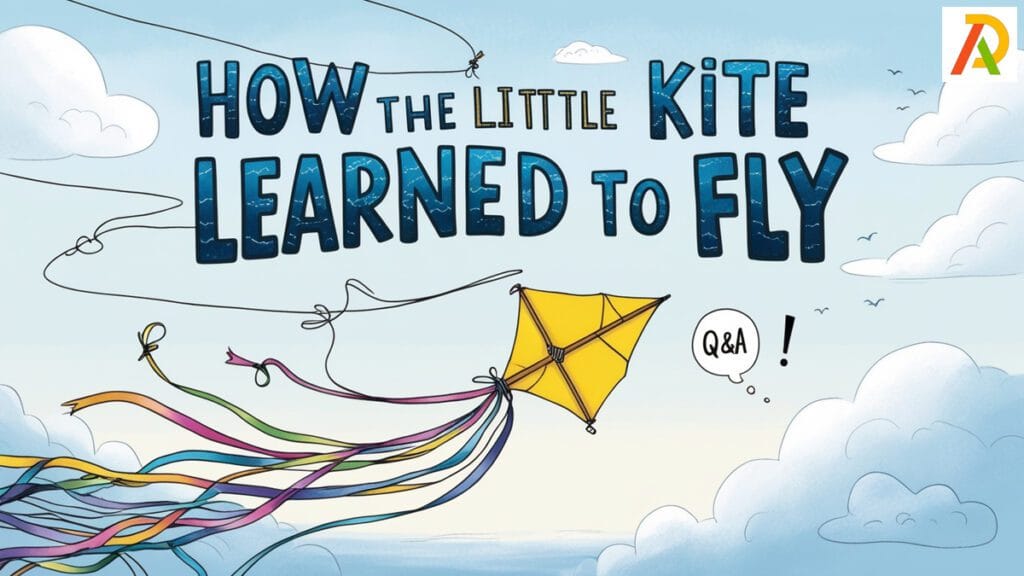How the Little Kite Learned to Fly questions and answers

Flying high in the sky is a dream for every kite. But for the little kite, fear held it back. It is how the little kite learned to fly, overcoming doubt and discovering its true potential. In this blog, we will explore the inspiring journey of the little kite, its struggles and triumphs, and the valuable lessons it teaches us. We’ll also dive into How the Little Kite Learned to Fly questions and answers to deepen our understanding of this timeless poem.
Summary of How the Little Kite Learned to Fly
The poem “How the Little Kite Learned to Fly” by Katharine Pyle tells the story of a minor, timid kite afraid to take flight. The little kite expresses its fear, believing it will surely fall if it tries to fly. However, an older, wiser kite encourages it, explaining that it must be brave and take risks. Initially hesitant, the little kite watches as the big kite soars high into the sky.
The little kite finally decides to try. It wobbles at first but gradually gains confidence as it rises higher and higher. Soon, the little kite is soaring joyfully, realizing its fear is unnecessary. It experiences the thrill of flying, enjoying the vast blue sky below.
First Attempt and the Fear
“I never can do it,” the little kite said, watching the others soar above. Fear held it back, afraid of falling. The big kite encouraged, “Try! Only try! Or you may never learn at all.” But doubt still clouded the little kite’s mind. As the big kite soared into the sky, the little kite trembled. But something inside it stirred—a tiny spark of courage. Shaking itself free, it lifted off the ground, uncertain but willing to try.
Rising with Courage
At first, the little kite whirled and wobbled, frightened by the open sky. The wind felt strong, almost too firm, and fear nearly pulled it down again. But remembering the big kite’s words, it steadied itself. Slowly, it rose, bit by bit, catching the wind instead of resisting it. Higher and higher it went, the world below shrinking, its confidence growing.
The Joy of Flight
“You’re flying!” the big kite called from above. The little kite, now soaring beside it, beamed with pride. The sky no longer seemed frightening—it was open, endless, and welcoming. Looking down, it saw the world as a patchwork of colors, the boys below appearing as tiny moving dots. The once-distant sky now felt like home.
Triumph in the Sky
“Oh, how happy I am!” the little kite cried. “And all because I was brave and tried.” It had conquered its fears, realizing that courage and persistence made all the difference. Drifting beside the big kite, the little one knew it had learned to fly—not just with the wind, but with belief in itself.
The poem teaches an essential lesson about overcoming fear and self-doubt. Like the little kite, people may hesitate to take risks, but they can achieve great heights with determination and encouragement. The story serves as a metaphor for personal growth, emphasizing that courage and perseverance can lead to success. Through the little kite’s journey, the poem inspires readers to believe in themselves and confidently embrace challenges. For those seeking more profound insights into how the little kite learned to fly questions and answers can further enhance understanding and appreciation of the poem’s message.
About Katharine Pyle
Katharine Pyle was a gifted American writer, poet, and illustrator known for enchanting children’s stories and poetry. Born in 1863, she was the younger sister of the famous artist and writer Howard Pyle. Like her brother, she was passionate about storytelling and art. She devoted her life to creating imaginative stories that enthralled young readers. She wrote and illustrated numerous books, often drawing inspiration from folklore, fairy tales, and themes of courage and perseverance.
One of her most beloved poems, How the Little Kite Learned to Fly, beautifully captures her ability to weave life lessons into simple yet profound storytelling. In this poem, she uses the journey of a minor, timid kite to convey an essential message about overcoming fear and self-doubt. Through gentle, rhythmic verses, Pyle illustrates how encouragement and determination can help one rise above challenges—literally and metaphorically. The little kite’s hesitation mirrors our fears, while its eventual flight symbolizes the triumph of courage and confidence.
Pyle’s writing often reflected her deep understanding of human emotions, especially those of children. She had a unique way of making life lessons accessible, using relatable characters and engaging narratives how the Little Kite Learned to Fly remains timeless, inspiring generations of readers to believe in themselves and embrace new challenges. Through this simple yet powerful poem, Katharine Pyle created a charming story and imparted a universal truth: bravery leads to success. Her legacy as a storyteller continues, reminding us that sometimes, we just need to take that first leap of faith.
Beginning of the Little Kite’s Journey
It was a bright and breezy afternoon, perfect for flying kites. The sky stretched wide and open, inviting the colorful kites to dance among the clouds. Several kites prepared to take flight as the wind whispered through the air, their tails fluttering excitedly. Among them stood a tiny, much smaller, and more delicate kite than the others. Unlike the others, who eagerly soared upward, the little kite hesitated.
As it gazed at the vast sky above, fear tightened its heart. The thought of leaving the ground, of being lifted so high, was terrifying. What if the wind was too strong? What if it lost control and crashed? These worries made the little kite doubt itself.
“I can’t do it,” the little kite murmured, its frame trembling. “What if I fall?”
High above, the big kite soared effortlessly, gliding with grace. Seeing the little kite’s hesitation, it gently called out, “You must try. The wind is your friend. It will carry you upward, and you will see the world from above in ways you never imagined.”
The little kite listened, torn between fear and curiosity, wondering if it dared to take flight.
Facing the First Challenge
Despite the gentle encouragement of the big kite, the little kite remained frozen with fear. From the ground, it watched as other kites soared gracefully, their colorful tails fluttering like ribbons in the breeze. The sky stretched endlessly above, vast and intimidating. How could something as small and uncertain as itself hope to join them? Doubt clouded its mind, whispering that it was too weak, too inexperienced to rise like the others.
The wise big kite spoke reassuringly, Sensing the little kite’s hesitation. “The wind may feel strong,” it said, “but it is not your enemy. It will lift you if you trust it. Take a deep breath, believe in yourself, and overcome your fears.”
Trembling but determined, the little kite finally gathered the courage to move. It lifted slightly, feeling the first touch of the wind against its frame. The air tugged at it, making it sway unsteadily. For a moment, it felt as if it might tumble back down. The sensation was thrilling and terrifying, but something within the little kite stirred—a spark of excitement, a whisper of possibility. Perhaps, just perhaps, it was meant to fly after all.
Lessons from the Little Kite’s Journey
The heartwarming journey of the little kite in Katharine Pyle’s poem How the Little Kite Learned to Fly carries profound life lessons that resonate with children and adults. The story of the small, hesitant kite transforming into a confident flier reflects the universal struggles of fear, self-doubt, and growth.
1. Courage Overcomes Fear
At the start, the little kite is gripped by fear, convinced that attempting to fly will only lead to failure. It hesitates, paralyzed by self-doubt, much like people often feel when faced with new challenges. However, the wise older kite gently encourages it, reminding us that fear is only as powerful as we allow it to be. The moment the little kite gathers courage and takes the risk, it realizes that the sky is not as intimidating as it once seemed. It mirrors real-life situations where stepping outside our comfort zone often leads to incredible growth and achievement.
2. Failure is a Stepping Stone
The little kite does not instantly soar; it wobbles and struggles at first. However, instead of giving up, it keeps trying. It reflects an essential truth—failure is not the end but a necessary step in the learning process. Just as the little kite gains balance with persistence, we must embrace setbacks as opportunities to improve. Every misstep teaches valuable lessons, shaping us into stronger, wiser individuals.
3. Trust in the Process
Initially, the little kite lacks confidence, doubting its ability to fly. But once it lets go of fear and believes in itself, it experiences the joy of soaring high. This serves as a reminder that trust—both in oneself and the learning process—is key to success. We often realize we are capable when we push past doubt and embrace the journey.
Through the little kite’s journey, Pyle beautifully conveys the power of courage, resilience, and self-belief, inspiring readers to embrace challenges and take flight in their own lives.
Read Like a Writer: Use a Story to Teach a Lesson
In this poem, Pyle tells the story of a kite overcoming its fears of flying high in the sky to teach readers about being brave and trying new things, even when scared. Pyle’s approach embodies it in a narrative without being overly didactic or heavy-handed. Spend some time talking with students about Pyle’s lesson in this poem and how writers use stories to help readers understand lessons that might otherwise be hard to teach. You can also explore how the little kite learned to fly questions and answers to help students analyze the poem in depth. Discussing these questions can encourage critical thinking and a deeper understanding of the story’s message.
How the Little Kite Learned to Fly Questions and Answers
Katharine Pyle’s poem How the Little Kite Learned to Fly is a beautiful metaphor for overcoming fear and embracing new challenges. The story of the hesitant little kite, who learns to trust itself and the wind, offers valuable lessons about courage, perseverance, and self-belief. Many readers seek how the little kite learned to fly questions and answers to explore the poem’s themes and lessons in depth. Below is a detailed discussion of key questions and answers related to the poem.
Q1: Why was the little kite afraid to fly?
The poem’s little kite is initially full of fear and self-doubt. It believes that if it tries to fly, it will surely fall. This fear of failure paralyzes the kite, preventing it from attempting to fly. Many people experience this hesitation when facing new or unfamiliar challenges. Like the little kite, we often let fear hold us back, assuming we are not strong or capable enough.
Q2: How did the big kite encourage the little kite?
The big kite, acting as a mentor figure, offers encouragement. It reassures the little kite that the wind will support it, but only if it dares to try. The big kite’s guidance is a reminder of how vital encouragement and belief from others can be when facing self-doubt. Just as a mentor, teacher, or friend can help us believe in ourselves, the big kite’s words motivate the little kite to take a leap of faith.
Q3: What happened when the little kite first attempted to fly?
Despite the encouragement, the little kite’s first attempt is unsuccessful. As it wobbles to rise, it quickly loses control and falls back down. This initial failure could have discouraged the little kite, but instead, it served as a learning experience. The struggle reflects how people often stumble when trying something new, but failure is simply part of the journey toward success.
Q4: How did the little kite finally succeed?
Instead of giving up, the little kite decides to try again. This time, it begins to trust the wind and gains confidence in its ability. Slowly but surely, it rises higher and higher until it soars freely in the sky. This transformation represents how perseverance and self-belief can lead to achievement. Once we push past our fears and keep trying, success becomes possible.
Q5: What are the key lessons from this story?
The poem teaches important life lessons:
- Courage conquers fear – Fear is natural, but facing it head-on allows us to grow.
- Failure is a stepping stone – Every mistake is an opportunity to improve.
- Belief leads to success – Trusting in ourselves and the process helps us achieve great heights.
Ultimately, How the Little Kite Learned to Fly is a timeless reminder that taking the first step, despite fear, is the key to unlocking our true potential.
Read more articles on education and career tips
Conclusion
The journey of the little kite in Katharine Pyle’s How the Little Kite Learned to Fly is a touching reminder that fear and doubt often hold us back from achieving our true potential. The poem beautifully conveys the importance of courage, perseverance, and self-belief through the little kite’s struggles and triumphs. It teaches that failure is not the end but a stepping stone toward success. Just as the little kite wobbled before soaring, we must embrace challenges with determination and trust in our abilities.
For those looking to explore How the Little Kite Learned to Fly in-depth, understanding How the little kite learned to fly questions and answers can offer more significant insights into its meaning. Pyle’s storytelling resonates deeply, inspiring readers to take that first leap of faith, knowing that growth comes through experience. Whether in school, work, or personal aspirations, we all have moments of hesitation. However, we can rise above our fears and reach new heights with encouragement and persistence. The poem remains a timeless lesson in resilience, proving that, like the little kite, we are all meant to fly.


